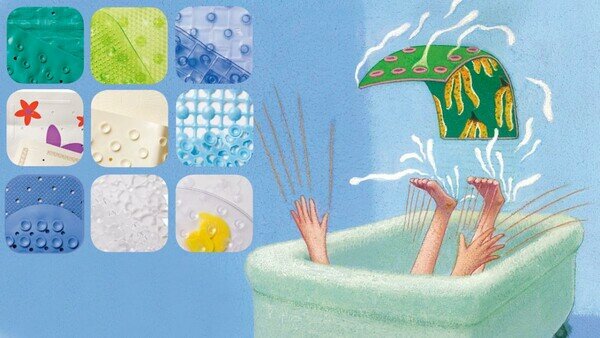With bathroom being a home accident black spot, many people lay a non-slip mat on the wet surface of bathtub, shower tray or bath area to minimise the risk of slips. However, the Consumer Council tested 34 bath and shower mats in the market and found that the slip resistance of 9 models fall below the minimum requirements set in the testing standard.
All the 34 models carried claims of “slip resistant”, “anti-slip”, “non-slip” or “skid resistant” are meant for use in bathtub or shower tray. The test was conducted with reference to a British standard which sets the minimum slip resistance performance standard of domestic bath and shower mats. In the test, the trial users walked barefoot backwards and forwards in a steady pace over the mat placed on a inclinable ramp, while a solution of warm soapy water flowed across the feet and mat surface continuously. The angle of the ramp was adjusted upward gradually from the horizontal level until the user could no longer walk safely.
Results showed that for 9 models the user slipped before the ramp was tilted to 14°. Their mean value of angle of insecurity lies between 6.19° and 13.82°, which means that they did not achieve the minimum performance requirements set in the testing standard and their level of slip resistance is unsatisfactory.
As for the other 25 models, 6 met the requirements for “comfort” mat with a mean value of angle of insecurity lying between 14.32° and 19.72°, which may have “moderate” slip potential. Although these models give users a comfortable feeling, they may not significantly improve the slip resistance of the bathtub.
19 models have a mean value of angle of insecurity lying between 20.79° and 29.65° and were classified as “slip resistant”. They may offer a greater degree of protection against slips.
On inspection of the 9 models, the Council believed that the poor anti-slip performance is probably due to a number of factors, such as the materials used, elasticity and softness of the materials, as well as the distribution of suction cups on the bottom surface. These factors may affect the degree of adhesion to the floor surface.
Of the 9 models, the suction cup of individual model sparsely distributed on the peripheral and the centre. Although the suction cups are evenly distributed in some models, the materials affect elasticity of the suction cups so that the mat is still undulating although put on a level surface. And deformed suction cups were also found in some models.
Overall, models claimed to be made from rubber met the requirements for “slip resistant” with comparatively good anti-slip performance.
The test also showed that the price and performance of the anti-slip mats may not be directly related. The samples formed to be slip resistant in the test are sold between $12 and $550 while the price for 9 under-performed models ranged from $12 to $188.
Here are some advice for consumers when choosing and using bath and shower mats:
- Measure the dimensions of the bathtub or shower tray at home and choose a mat of the suitable size. The edges may roll up and posing trip hazards if the mat is too large;
- When choosing a bath and shower mat, test its level of adhesion on a level surface. Avoid models that cannot be flattened easily, with unevenly distributed suction cups or unable to effectively adhere to the surface;
- Anti-slip mats with deep patterns or a rough surface can reduce the chance of slips and falls;
- Newly bought bath and shower mat may have fold marks. Immerse the mat in warm water or stack heavy objects on it to flatten it before use;
- Make sure the floor surface is clean before laying a bath and shower mat on it, otherwise the suction cups may not be able to adhere effectively on the shower base. If that is the case, remove the mat to avoid accidents;
- Stand on the centre of the bath and shower mat as far as possible when moving in and out of the shower area. Dry your hair, body and soles before stepping out;
- After shower, hang the bath and shower mat up to let it dry naturally; wash its surface and bottom frequently because residual soap suds favour fungal growth which may affect the slip-resistant performance. Should there be any damages or rolled up edges on the mat, replace it as soon as possible;
- Bath oil can make bath and shower mats less slip-resistant;
- For the elderly at home, it is suggested to convert the bathtub into a barrier-free that is shower space or with lower floor platform. Install reliable bathroom handrails and use non-slip floor tiles or bath and shower mats for ease of use by the elderly.
The Consumer Council reserves all its right (including copyright) in respect of CHOICE magazine and Online CHOICE (https://echoice.consumer.org.hk/).



